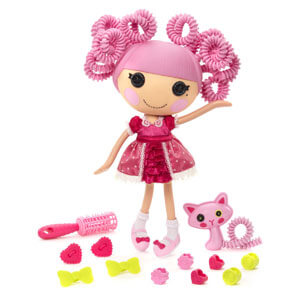One of my favorite things to do at this time of year when toys are top of mind for nearly everyone, is to explain to baffled adults-admittedly most of whom don’t have young kids-the wonder of a toy that does “nothing,” for example, a doll, stuffed animal, or other toy that doesn’t have an electronic chip in it. Second best is the incredulous question/statement, “You mean that’s ALL it does?!”
Actually, it’s an understandable question. With pockets, purses and briefcases full of gadgets that do amazing things at a touch, and with the fascination that kids have with mom and dad’s technology—and the constant desire to play with these items, too—it’s easy to think that tech is all that kids want.
I’ve gotten this question a lot around one toy in particular this year: LaLaLoopsy Silly Hair. It’s almost inconceivable to many adults that a doll that does nothing and has flexible “hair” could be so popular. Parents tell me they don’t “get” it—even as they’re finding it difficult to get from sold out stores.
Well, let me put it in terms that may be a little easier to understand. LaLaLoopsy and other similar toys rely on a “technology” so sophisticated that it has been studied for years without being fully understood. That is: a child’s imagination.
Play happens in the mind. It can’t be measured by the amount of memory available, the responsiveness of a capacitive touch screen or the rendering speed of graphics. All of those are almost ridiculously simple when compared to the power of a child’s imagination. And no two are alike. Whether it’s a Barbie, a LEGO set, a Transformers action figure or LaLaLoopsy, the experience of each one will be unique because of the way the child brings it to life. The toy is merely a plastic catalyst for the experience that the child creates in his or her mind. And therein lies the joy of the toy play experience because it is as much about self-discovery and self-expression as it is about the literal toy.
This is not to criticize technology in any way. There are wonderful tech toys out there that help kids learn and have experiences, but they activate different centers of the brain. That’s why we always talk about the importance of diverse play experience for kids—the balanced toy box.
So, here’s an idea: The next time you or someone near you wonders about a toy that seems to do “nothing,” take a moment to imagine the story you would create about or with that toy. And—just like that—you’ll be playing, too.

